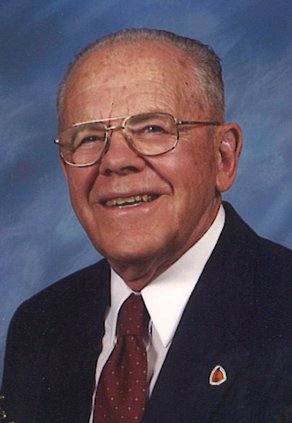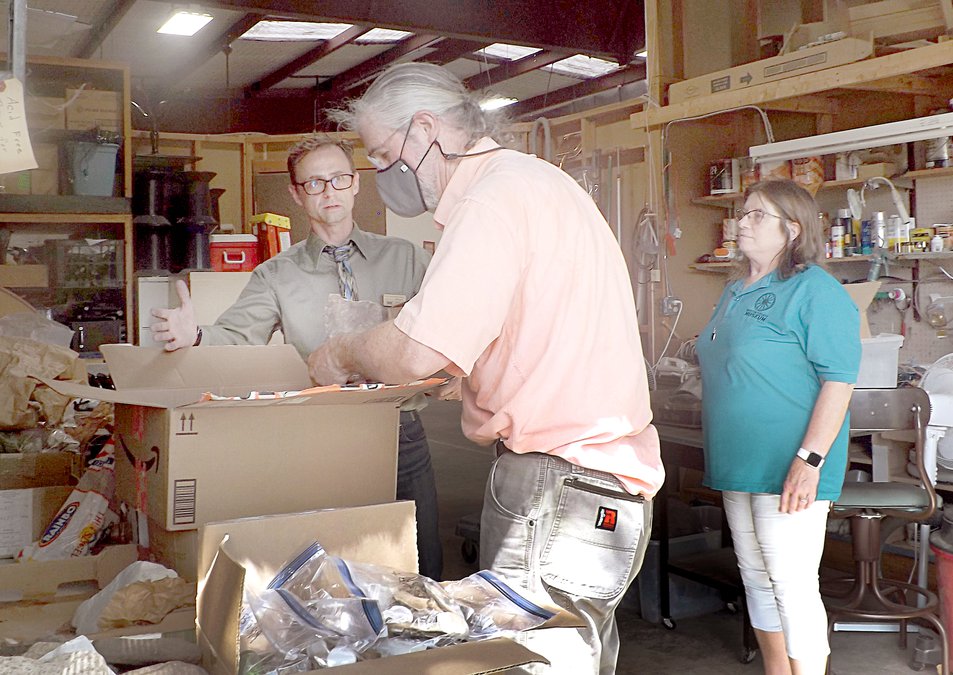A local historian’s legacy will live on in Topeka.
Last week, items donated to the Barton County Historical Society from the estate of the late Bob Button were transferred to the custody of the Kansas State Historical Society, where they will help educate future generations about the rich diverse history of the Golden Belt.
Following his passing in October 2020, the remainder of Button’s personal collection of archeological finds was donated to the Barton County Historical Society Museum and Village and the Santa Fe Trail Center. As part of the donation, Button’s family directed any items the BCHS could not use to be donated to the state historical society, with whom Button worked extensively throughout his life as he helped excavate area archeological sites.
Button’s daughter, Judy VonFeldt, said it was important to the family to keep her father’s collection as local as possible upon his passing, given his passion for the area’s rich history.
KHS State Archeologist Robert Hoard, who received the collection for the state historical society, was grateful to be able to accept the collection.
“This is a valuable collection,” he told BCHS Director Richard Lartz II, “I really appreciate you sharing it with us.”
Once in Topeka, the items will be documented, weighed, and catalogued with site numbers, connecting them to specific sites in the area. Hoard said Button’s detailed record keeping of his finds in this regard would be crucial in helping researchers connect the finds with existing sites.
About Bob Button’s work
VonFeldt said that while her dad had no formal archeological training, what he did have was a passion for history and for learning, particularly when it came to the region’s diverse history. Her dad loved learning about Native American cultures, early U.S. military forts, and the settlement period in the state’s history.
VonFeldt recalled her father having a vast collection of books, which he was always digging into. He had a passion for learning, she said.
During his life, Button was involved in several organizations dedicated to learning, history and the arts. He was a member of the Kansas State Anthropological Association, the Santa Fe Trail Association, the Barton County Historical Society, the Shafer Art Gallery, the Great Bend Public Library and more.
“He was a very avid collector and reader,” VonFeldt said. “If there was (a chance to learn more), he was there.”
Though he was a farmer by trade, and did not train formally, VonFeldt said her dad was extremely knowledgeable and experienced in archaeology.
When Button became involved in archeology in the 1950’s and 60’s, helping excavate sites throughout the region, VonFeldt said formal academic training was far less common, and many like her dad learned through hands-on training, and by working closely with the Kansas Historical Society.
And VonFeldt said Button spent extensive time in the pursuit. She recalled times when he would get calls from fellow area farmers about artifact finds they had made, and his kids would accompany him and walk the fields with him searching for the items.
She recalled one incident in particular when receding floodwaters from the Wet Walnut Creek uncovered skeletal remains, and once they were deemed by law enforcement not to be recent, he and several other local archeologists worked to further excavate the site.
Button’s meticulous nature, she said, made him ideally suited to the arduous work of archeology. He was extremely detailed about cataloging finds, including times, dates, collection numbers and locations of his finds.
He even had a special plaster-of-Paris formula so that when he encountered broken fragments of Native American pottery, he would painstakingly piece the artifact together, and use the plaster to fill in any gaps in the artifact.
“It was amazing what he could do,” VonFeldt said.
He was also a skilled wood carver, with several of his Native American carvings still on display at the Barton County Historical Society Museum and Village. VonFeldt said he was able to accurately reproduce carvings from pictures in a book of Native American carvings.
Public contribution is crucial
Hoard said Button was one of many area residents who contribute regularly to learning more about the state’s history through archeology.
“The public contribution to archeology in Kansas is huge,” Hoard said, noting many residents have contributed significant amounts of knowledge about the area to historical records.
In fact, he said, people like Button are essential to helping preserve, and learn more about the region’s - and the state’s - history.
Each year, he said, the state historical society hosts the Kansas Archeology Training Program, which gives residents wanting to learn more about archeology an opportunity to work alongside professional archeologists in surveying and excavating archeological sites in Kansas.
Those wanting to learn more about the program, Hoard said, can visit the program website at www.kshs.org/p/kansas-archeology-training-program-field-school/14623.







